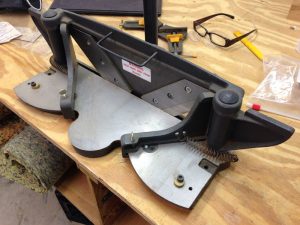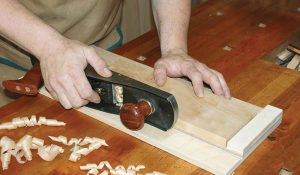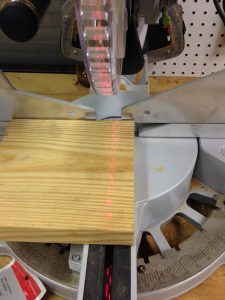Measure twice, cut once.
Such sayings are legendary, sage advice.
We all know that accuracy is one of the most important factors in a good woodworking outcome. Usually, it’s a matter of “taking the time.” Taking time to mark accurately, line up a cut accurately, and execute the cut accurately.
Whether a butt joint or miter, few aspects of your work can make it look uglier than an ill-fitting intersection.

A perfectly-executed half-lap joint by Marc Spagnuolo.
There are plenty of ways you can enhance accuracy. Marking your cutlines with a knife instead of a pencil, for example.
Many woodworkers intentionally cut their pieces long and fine-tune after.
Picture framers often “shave” their miter cuts for accuracy to the thousandth.

When nothing less than perfection will do, nothing beats making one’s cuts a tad long and improving them with this miter trimmer. Highland provides a handy product tour.

Shooting boards. I suppose they’ve been around almost as long as hand planes.

The laser guide on this Kapex is quite good, although I usually still cut and test.
Some would argue that accuracy isn’t improved, even though most people would say speed is. This month’s poll asks about your preferences regarding lasers.
Jim Randolph is a veterinarian in Long Beach, Mississippi. His earlier careers as lawn mower, dairy farmer, automobile mechanic, microwave communications electronics instructor and journeyman carpenter all influence his approach to woodworking. His favorite projects are furniture built for his wife, Brenda, and for their children and grandchildren. His and Brenda’s home, nicknamed Sticks-In-The-Mud, is built on pilings (sticks) near the wetlands (mud) on a bayou off Jourdan River. His shop is in the lower level of their home.Questions and comments on woodworking may be written below in the comments section. Questions about pet care should be directed to his blog on pet care, www.MyPetsDoctor.com. We regret that, because of high volume, not all inquiries can be answered personally.


Most of my woodworking projects require great accuracy. The laser on my Festool Kapex is very good, but not fine enough for “perfect” cuts. I use a fine pencil line, lower the blade to the line and tap the board into place. If I’m doing rough work, like park benches, the laser is more than adequate.
I answered that mine are tuned and completely trustworthy…and that’s the closest answer to the truth…but I still don’t cut unless I check first. No matter what. I have one on my miter saw and another on my drill press. 99.9% of the time, they’re right on, but that doesn’t mean I don’t make sure before I start to cut.
My miter saw has a laser. after cutting a lot of sappy pine it was splattered with goo so I put a piece of masking tape over it until I feel like cleaning it up. I haven’t even missed it. The red laser line is way too fat to be useful for anything precise.
Good to hear from you, Michael. How’s the new shop working out?
My power miter saw has a very bright work light that projects a shadow of the blade edges and I can make fine adjustments to the knifed mark just prior to cutting and it is nearly always right on the money.
Jeff, I saw that technique in a finish carpenter’s video recently. Nice!
My miter saw has a laser but it’s not true to where the cut is so I’m not sure the usefulness… wouldn’t trust it for anything that needs precision.